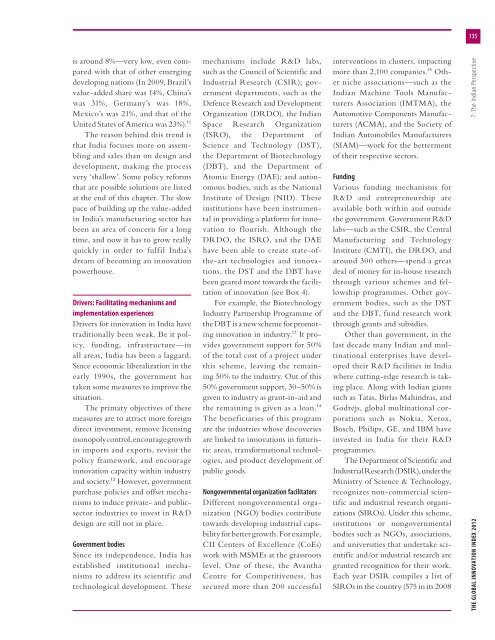The Global Innovation Index 2012
The Global Innovation Index 2012
The Global Innovation Index 2012
Create successful ePaper yourself
Turn your PDF publications into a flip-book with our unique Google optimized e-Paper software.
is around 8%—very low, even compared<br />
with that of other emerging<br />
developing nations (In 2009, Brazil’s<br />
value-added share was 14%, China’s<br />
was 31%, Germany’s was 18%,<br />
Mexico’s was 21%, and that of the<br />
United States of America was 23%).11<br />
<strong>The</strong> reason behind this trend is<br />
that India focuses more on assembling<br />
and sales than on design and<br />
development, making the process<br />
very ‘shallow’. Some policy reforms<br />
that are possible solutions are listed<br />
at the end of this chapter. <strong>The</strong> slow<br />
pace of building up the value-added<br />
in India’s manufacturing sector has<br />
been an area of concern for a long<br />
time, and now it has to grow really<br />
quickly in order to fulfil India’s<br />
dream of becoming an innovation<br />
powerhouse.<br />
Drivers: Facilitating mechanisms and<br />
implementation experiences<br />
Drivers for innovation in India have<br />
traditionally been weak. Be it policy,<br />
funding, infrastructure—in<br />
all areas, India has been a laggard.<br />
Since economic liberalization in the<br />
early 1990s, the government has<br />
taken some measures to improve the<br />
situation.<br />
<strong>The</strong> primary objectives of these<br />
measures are to attract more foreign<br />
direct investment, remove licensing<br />
monopoly control, encourage growth<br />
in imports and exports, revisit the<br />
policy framework, and encourage<br />
innovation capacity within industry<br />
and society.12 However, government<br />
purchase policies and offset mechanisms<br />
to induce private- and publicsector<br />
industries to invest in R&D<br />
design are still not in place.<br />
Government bodies<br />
Since its independence, India has<br />
established institutional mechanisms<br />
to address its scientific and<br />
technological development. <strong>The</strong>se<br />
mechanisms include R&D labs,<br />
such as the Council of Scientific and<br />
Industrial Research (CSIR); government<br />
departments, such as the<br />
Defence Research and Development<br />
Organization (DRDO), the Indian<br />
Space Research Organization<br />
(ISRO), the Department of<br />
Science and Technology (DST),<br />
the Department of Biotechnology<br />
(DBT), and the Department of<br />
Atomic Energy (DAE); and autonomous<br />
bodies, such as the National<br />
Institute of Design (NID). <strong>The</strong>se<br />
institutions have been instrumental<br />
in providing a platform for innovation<br />
to flourish. Although the<br />
DRDO, the ISRO, and the DAE<br />
have been able to create state-ofthe-art<br />
technologies and innovations,<br />
the DST and the DBT have<br />
been geared more towards the facilitation<br />
of innovation (see Box 4).<br />
For example, the Biotechnology<br />
Industry Partnership Programme of<br />
the DBT is a new scheme for promoting<br />
innovation in industry.13 It provides<br />
government support for 50%<br />
of the total cost of a project under<br />
this scheme, leaving the remaining<br />
50% to the industry. Out of this<br />
50% government support, 30–50% is<br />
given to industry as grant-in-aid and<br />
the remaining is given as a loan.14<br />
<strong>The</strong> beneficiaries of this program<br />
are the industries whose discoveries<br />
are linked to innovations in futuristic<br />
areas, transformational technologies,<br />
and product development of<br />
public goods.<br />
Nongovernmental organization facilitators<br />
Different nongovernmental organization<br />
(NGO) bodies contribute<br />
towards developing industrial capability<br />
for better growth. For example,<br />
CII Centers of Excellence (CoEs)<br />
work with MSMEs at the grassroots<br />
level. One of these, the Avantha<br />
Centre for Competitiveness, has<br />
secured more than 200 successful<br />
interventions in clusters, impacting<br />
more than 2,100 companies.15 Other<br />
niche associations—such as the<br />
Indian Machine Tools Manufacturers<br />
Association (IMTMA), the<br />
Automotive Components Manufacturers<br />
(ACMA), and the Society of<br />
Indian Automobiles Manufacturers<br />
(SIAM)—work for the betterment<br />
of their respective sectors.<br />
Funding<br />
Various funding mechanisms for<br />
R&D and entrepreneurship are<br />
available both within and outside<br />
the government. Government R&D<br />
labs—such as the CSIR, the Central<br />
Manufacturing and Technology<br />
Institute (CMTI), the DRDO, and<br />
around 300 others—spend a great<br />
deal of money for in-house research<br />
through various schemes and fellowship<br />
programmes. Other government<br />
bodies, such as the DST<br />
and the DBT, fund research work<br />
through grants and subsidies.<br />
Other than government, in the<br />
last decade many Indian and multinational<br />
enterprises have developed<br />
their R&D facilities in India<br />
where cutting-edge research is taking<br />
place. Along with Indian giants<br />
such as Tatas, Birlas Mahindras, and<br />
Godrejs, global multinational corporations<br />
such as Nokia, Xerox,<br />
Bosch, Philips, GE, and IBM have<br />
invested in India for their R&D<br />
programmes.<br />
<strong>The</strong> Department of Scientific and<br />
Industrial Research (DSIR), under the<br />
Ministry of Science & Technology,<br />
recognizes non-commercial scientific<br />
and industrial research organizations<br />
(SIROs). Under this scheme,<br />
institutions or nongovernmental<br />
bodies such as NGOs, associations,<br />
and universities that undertake scientific<br />
and/or industrial research are<br />
granted recognition for their work.<br />
Each year DSIR compiles a list of<br />
SIROs in the country (575 in its 2008<br />
135<br />
THE GLOBAL INNOVATION INDEX <strong>2012</strong> 7: <strong>The</strong> Indian Perspective






